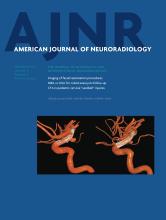Index by author
September 01, 2014; Volume 35,Issue 9
Favaro, A.
- BrainYou have accessBrain Changes in Kallmann SyndromeR. Manara, A. Salvalaggio, A. Favaro, V. Palumbo, V. Citton, A. Elefante, A. Brunetti, F. Di Salle, G. Bonanni, A.A. Sinisi and for the Kallmann Syndrome Neuroradiological Study GroupAmerican Journal of Neuroradiology September 2014, 35 (9) 1700-1706; DOI: https://doi.org/10.3174/ajnr.A3946
Fiorella, D.
- Level 1 EBM Expedited PublicationOpen AccessPatients Prone to Recurrence after Endovascular Treatment: Periprocedural Results of the PRET Randomized Trial on Large and Recurrent AneurysmsJ. Raymond, R. Klink, M. Chagnon, S.L. Barnwell, A.J. Evans, J. Mocco, B.L. Hoh, A.S. Turk, R.D. Turner, H. Desal, D. Fiorella, S. Bracard, A. Weill, F. Guilbert and D. Roy on behalf of the PRET Collaborative GroupAmerican Journal of Neuroradiology September 2014, 35 (9) 1667-1676; DOI: https://doi.org/10.3174/ajnr.A4035
Fugate, J.E.
- FELLOWS' JOURNAL CLUBBrainYou have accessEarly Basal Ganglia Hyperperfusion on CT Perfusion in Acute Ischemic Stroke: A Marker of Irreversible Damage?V. Shahi, J.E. Fugate, D.F. Kallmes and A.A. RabinsteinAmerican Journal of Neuroradiology September 2014, 35 (9) 1688-1692; DOI: https://doi.org/10.3174/ajnr.A3935
These authors found that increased cerebral blood flow and volume were seen in the basal ganglia of 4.3% of patients with ischemic strokes with CT perfusion. All patients had underlying MCA occlusions, 30% underwent hemorrhagic transformations, and the hyperperfused areas eventually became infarcted in all. Thus, acute basal ganglia hyperperfusion in patients with stroke may indicate nonviable parenchyma.
In this issue
American Journal of Neuroradiology
Vol. 35, Issue 9
1 Sep 2014
Advertisement
Advertisement








